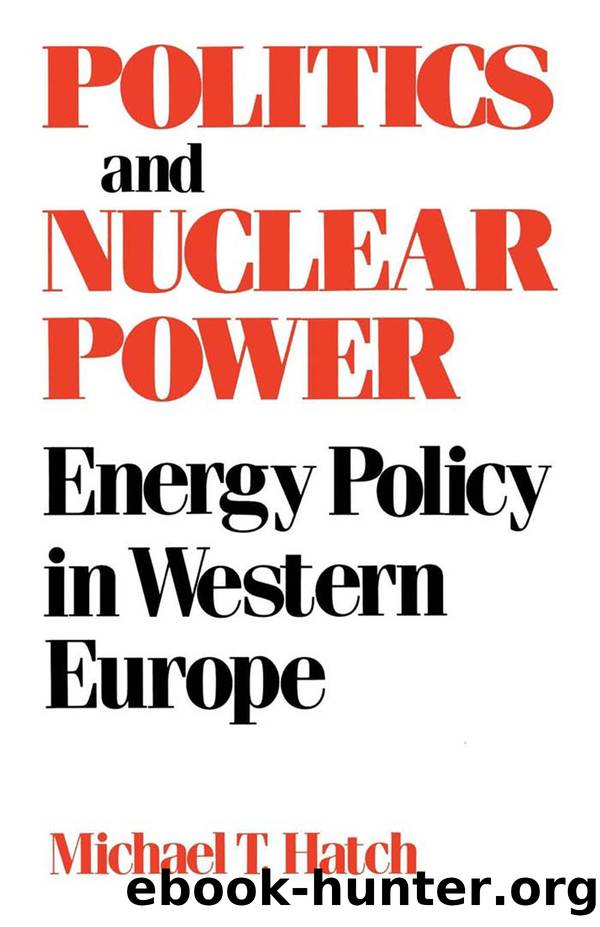Politics and Nuclear Power: Energy Policy in Western Europe by Michael T. Hatch

Author:Michael T. Hatch [Hatch, Michael T.]
Language: eng
Format: epub
Tags: Technology & Engineering, Public Policy, Nuclear, Europe, Western, Political Science, Power Resources, History, Science & Technology Policy
ISBN: 9780813181967
Google: 7gQaEAAAQBAJ
Goodreads: 3012264
Publisher: University Press of Kentucky
Published: 1986-01-01T00:00:00+00:00
A PLUTONIUM ECONOMY
Electoral considerations established the tactical context of domestic politics in the Federal Republic during much of the period from 1978 on. By early 1980, with United States-Soviet relations deteriorating in the wake of the Iranian revolution and the Afghanistan occupation, the status of the Atlantic alliance and East-West détente had also become issues of concern in the campaign. During 1981â82, the issue of nuclear rearmament became more prominent as the peace movement in West Germany gained momentum, lending greater strength to the Greens. With the deepening recession during the same period, economic policy began to receive greater attention. Finally, coalition politics came to dominate certain elections; in Hesse, the FDPâs tactics of abandoning the coalition in Bonn became the focal point of the election. Nevertheless, energy policy remained a principal substantive focus. The major points of controversy centered on two important components of the governmentâs energy program: reprocessing of nuclear waste and development of the fast breeder reactor.
For several reasons, these technologies seemed crucial to the future security of German energy supply:
⢠By closing the nuclear fuel cycle through the reprocessing of spent fuel rods from light water reactors (LWRs), substantial amounts of unused uranium could be recovered, thereby extending the supply of uranium, which otherwise would have to be imported.
⢠At the same time, plutonium produced in the operation of LWRs could be extracted and later be recycled as fuel for FBRs.
⢠By producing more plutonium than they consumed in their operation, FBRs represented one of the few technologies which, in the longer term, promised to reduce German dependence on dwindling foreign energy supplies, whether oil, uranium, or natural gas.
⢠Finally, reprocessing was a necessary stage in the disposal of nuclear waste. After separating those elements that could be re-used from leftover radioactive waste products, the most radioactive and long-lasting of these wastes were to be concentrated and permanently isolated from the environment.
The waste disposal problem had become the pivotal issue relating to the further expansion of nuclear power in the Federal Republic. Central to the governmentâs plan for nuclear waste disposal was the construction of a large, integrated facility designed to reprocess spent fuel rods and provide final burial for nuclear waste, all within a single site. This was called an Entsorgungszentrum. (There is no corresponding term in English. Literally translated, Entsorgung implies the alleviation of worry or concern.) Before 1977, this part of Germanyâs nuclear program received little public attention, but when further nuclear power plant construction was explicitly linked with safe disposal of nuclear waste in late 1976, pressure began to build for quicker action. The task of the private sector was to formulate plans for the reprocessing facilities; for its part, the federal government had to decide on a site suitable for long-term storage of high-level radioactive materials. Unfortunately for the government, this need for a rapid decision on the Entsorgungszentrum came just when the first effects of nationwide opposition to nuclear energy were beginning to have political impact. As a consequence, over
Download
This site does not store any files on its server. We only index and link to content provided by other sites. Please contact the content providers to delete copyright contents if any and email us, we'll remove relevant links or contents immediately.
| Automotive | Engineering |
| Transportation |
Whiskies Galore by Ian Buxton(41564)
Introduction to Aircraft Design (Cambridge Aerospace Series) by John P. Fielding(32908)
Small Unmanned Fixed-wing Aircraft Design by Andrew J. Keane Andras Sobester James P. Scanlan & András Sóbester & James P. Scanlan(32589)
Craft Beer for the Homebrewer by Michael Agnew(17954)
Turbulence by E. J. Noyes(7738)
The Complete Stick Figure Physics Tutorials by Allen Sarah(7162)
Kaplan MCAT General Chemistry Review by Kaplan(6630)
The Thirst by Nesbo Jo(6477)
Bad Blood by John Carreyrou(6295)
Modelling of Convective Heat and Mass Transfer in Rotating Flows by Igor V. Shevchuk(6245)
Learning SQL by Alan Beaulieu(6057)
Weapons of Math Destruction by Cathy O'Neil(5875)
Man-made Catastrophes and Risk Information Concealment by Dmitry Chernov & Didier Sornette(5689)
Digital Minimalism by Cal Newport;(5419)
Life 3.0: Being Human in the Age of Artificial Intelligence by Tegmark Max(5211)
iGen by Jean M. Twenge(5191)
Secrets of Antigravity Propulsion: Tesla, UFOs, and Classified Aerospace Technology by Ph.D. Paul A. Laviolette(5085)
Design of Trajectory Optimization Approach for Space Maneuver Vehicle Skip Entry Problems by Runqi Chai & Al Savvaris & Antonios Tsourdos & Senchun Chai(4859)
Electronic Devices & Circuits by Jacob Millman & Christos C. Halkias(4769)
